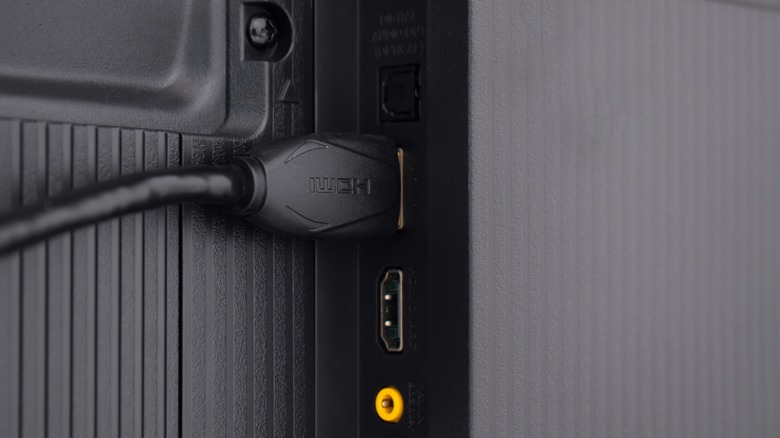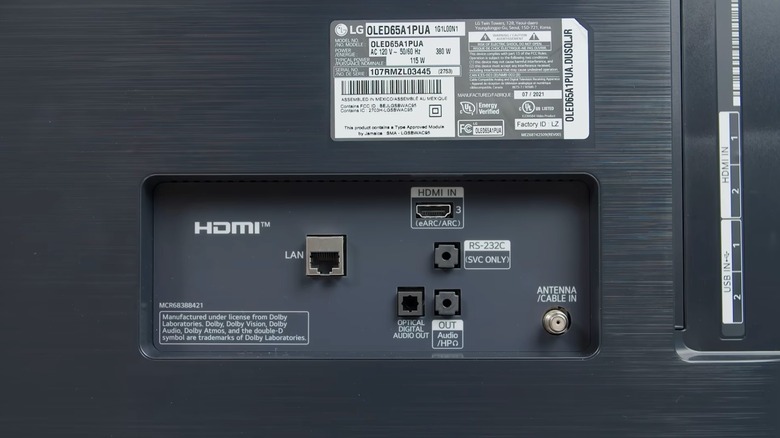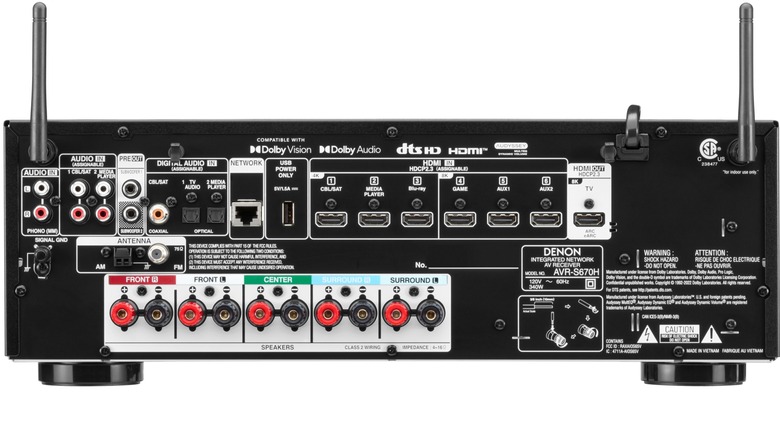What Is HDMI eARC On Your TV And When Should You Use It?
Over the years, there have been plenty of different ways to get audio into an AV receiver as part of your home theater setup. For components like DVD players, this was always fairly straightforward: You either plugged whatever you would normally plug into the TV, like stereo RCA cables or later HDMI, into the receiver, or you used a specialized digital audio SPDIF output like a digital coaxial audio or an optical TOSLINK cable.
However, what if you wanted to send audio from the TV itself to the receiver, like if you were using the TV's built-in tuner or just preferred to use its inputs for switching components? For that, you needed a TV with a dedicated output, and not every TV had that option. If they did, it was either RCA stereo or, later, one of the aforementioned digital outputs.
In time, though, more digital audio formats popped up, many of which SPDIF didn't support. On top of that, Smart TVs with built-in content hubs became the norm. There needed to be a better way to get audio from the TV itself to the receiver, and thankfully, one came about with the evolution of the HDMI spec Audio Return Channel in 2009 as part of HDMI 1.4. In 2017, the improved Enhanced ARC (eARC) was released as part of HDMI 2.1. Suddenly, sending TV audio to a receiver or soundbar was as simple as making sure that you were plugging those devices' HDMI cables — which were already feeding your TV via HDMI — into the right HDMI (e)ARC-compatible port.
What exactly is HDMI eARC and how does it work?
In January 2009, having just won an Emmy Award for an achievement in Technology and Engineering Excellence, HDMI Licensing LLC, the company in charge of the HDMI spec, announced its intentions for the upcoming HDMI 1.4 revision. Alongside the addition of networking capabilities, increased bandwidth to allow for 4K and 3D support, an automotive version of the standard, and a smaller version of the connector, was Audio Return Channel. ARC would allow for the elimination of SPDIF outputs on TVs by being able to carry audio back from the TV to an AV receiver while also sending video from the receiver to the TV. The official announcement came in May 2009, and before long, it was a standard feature of TVs and receivers once they implemented the HDMI 1.4 spec.
As much of an improvement as it was, ARC was limited. It only supported about a megabit per second of audio bandwidth, meaning that if you preferred using your TV's inputs, you were limited to sending lossless PCM stereo, lossy Dolby Digital surround, or lossy DTS surround to your receiver. It was very much a direct replacement for SPDIF, which had the same limitations, so if you wanted lossless surround or hi-res from a Blu-ray, the player needed to be plugged directly into your receiver. That changed in 2017 when HDMI 2.1 was launched with Enhanced ARC, complete with 37 megabits per second of audio bandwidth, more than enough for lossless, high-resolution surround.
When should I use HDMI eARC?
There are a few different reasons to use eARC with your receiver or soundbar, and we'll start with the two most obvious. Some soundbars don't have any additional HDMI ports beyond the eARC port, so it's basically a requirement, so that's simple enough. The other obvious reason is sending audio from your TV to your audio device, for example, if you're using your TV's tuner to watch over-the-air programming or streaming programming using your Smart TV's apps. In both cases, you don't have much of a choice. You need to use eARC.
Next up, there's using your TV's inputs for your streaming devices instead of the receiver or soundbar inputs (if available) and then using the TV to route the sound to the audio device via eARC. Being that receivers often have more inputs than TVs, you might be wondering why you'd do this. For starters, it's just less complicated for some people, as it requires less juggling of remotes, especially since the intertwined HDMI-CEC features let you control the receiver or soundbar volume with your TV remote. Another possible reason to use your TV's inputs and eARC is for gaming devices. If you connect the gaming console or PC directly to the TV and bypass any processing that the receiver might add, it might improve input lag while gaming.


